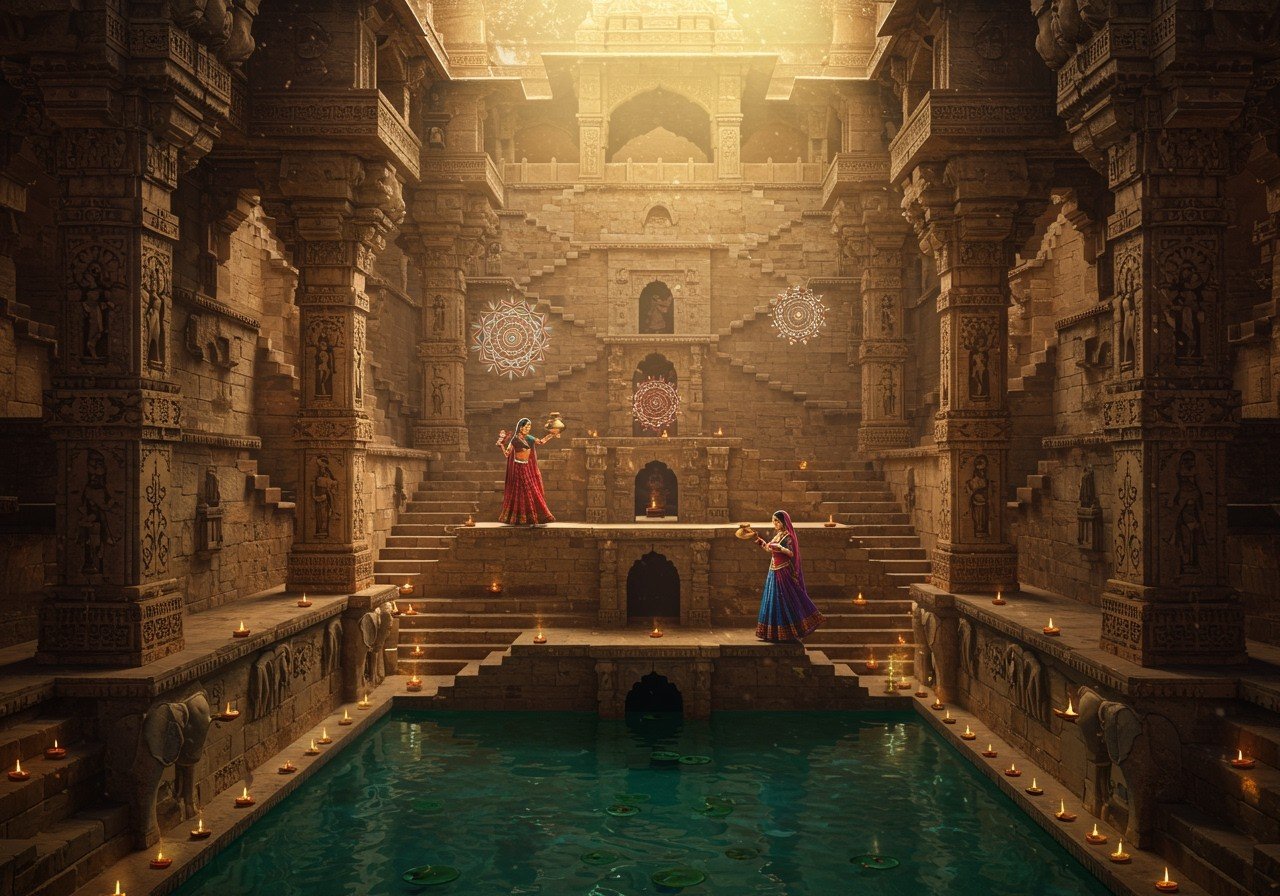
Stepwells, also known as baolis or vavs, are more than just ancient water reservoirs; they are captivating testaments to India’s architectural brilliance, sustainable water management, and rich cultural heritage. These subterranean structures, often found in arid regions, served as vital lifelines, social hubs, and artistic expressions of the communities they served.
The Genesis and Function of Stepwells
Dating back to the 3rd century BCE, stepwells arose from the necessity to access groundwater in dry regions. They ensured a consistent water supply during droughts, supporting agriculture, daily life, and community well-being. Beyond their utilitarian purpose, stepwells evolved into vibrant social centers where people congregated for festivals, rituals, and everyday interactions. Many were associated with temples, becoming pilgrimage sites imbued with religious significance. The act of fetching water, often performed by women, transformed these spaces into dynamic hubs of social exchange.
Architectural Marvels: Design and Engineering
Stepwells exemplify a remarkable diversity of architectural styles. Their features include multi-storied pavilions, intricate carvings depicting mythological stories and cultural motifs, and elaborate staircases that descend to the water’s edge. Famous examples like Rani ki Vav in Patan, Gujarat (a UNESCO World Heritage site constructed in the 11th century) are renowned for their stunning sculptures and ornate details. The engineering ingenuity displayed in these structures ensured easy access to fluctuating water levels through precisely calculated steps and innovative construction techniques. Regional variations in design and materials, evident in stepwells across Gujarat, Rajasthan, and Karnataka, reflect the unique cultural influences and available resources of each area. Stepwells served as a reflection of the socio-economic status of their patrons, seamlessly integrating art, architecture, and functionality.
Stepwells and Water Sustainability
As early examples of sustainable water management, stepwells played a crucial role in recharging groundwater levels and maintaining the water table. These structures incorporated innovative methods like rainwater harvesting and natural filtration systems. By storing monsoon rains, they provided a crucial water source during dry periods, contributing significantly to the ecological balance. Today, stepwells are being studied as valuable models for contemporary water conservation strategies. Restored stepwells are even being utilized for modern water management, demonstrating their enduring relevance.
Cultural Significance and Social Impact
Stepwells held deep cultural significance in ancient Indian society. They served as venues for festivals, rituals, and social gatherings, fostering a sense of community. The artistic carvings adorning these structures often depicted mythological stories and cultural motifs, adding layers of meaning to their function. Royal patronage and support from wealthy merchants reflected the status and devotion associated with these structures. Folklore and legends surrounding famous stepwells further enhanced their mystique. The daily activities of women at stepwells, particularly the act of fetching water, shaped social interactions and contributed to the vibrant cultural tapestry of ancient India. The influence of stepwells extended to literature and art, inspiring poets, writers, and artists.
Notable Stepwells Across India
-
Rani ki Vav, Patan, Gujarat: A UNESCO World Heritage site, this 11th-century marvel is celebrated for its intricate carvings depicting Hindu deities and mythological scenes. Explore similar spiritual journeys in Karnataka’s ancient temples.
-
Chand Baori, Abhaneri, Rajasthan: Known as one of India’s deepest and largest stepwells, Chand Baori boasts 3,500 narrow steps arranged in perfect symmetry, descending 13 stories to the water level.
-
Adalaj Stepwell, Adalaj, Gujarat: This 15th-century stepwell showcases a blend of Indo-Islamic architecture, featuring exquisite carvings that combine Islamic floral patterns with Hindu symbols.
These architectural wonders are not mere water sources; they are treasured remnants of India’s rich past, inspiring awe and admiration. You can find items related to traditional rituals, such as turmeric cream, incense sticks, and sindoor containers, at Poojn.in.
Preservation and Restoration: Safeguarding Heritage
Many ancient stepwells face challenges due to modernization, falling water tables, and past neglect. Some suffered destruction during British rule, while others were abandoned over time. The preservation of these structures is paramount for safeguarding India’s architectural heritage. Successful restoration projects, like Toorji Ka Jhalra in Jodhpur, demonstrate the potential for reviving these ancient marvels. Government bodies, NGOs, and community involvement play crucial roles in these conservation efforts. Modern techniques and technology aid in restoring these structures while maintaining their historical integrity, providing valuable insights into ancient construction methods. Restored stepwells attract tourists, promoting heritage tourism and educating future generations about India’s rich history.
Conclusion: A Legacy of Ingenuity and Sustainability
Stepwells in ancient India stand as timeless symbols of ingenuity, sustainability, and cultural richness. They represent a remarkable fusion of architectural brilliance, engineering prowess, and deep cultural significance. As we continue to preserve and appreciate these marvels, we honor the legacy of ancient Indian traditions and wisdom, ensuring that these treasures continue to inspire awe and admiration for generations to come.


